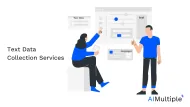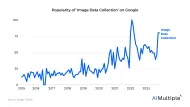Research Data Collection in 2024: Quick Guide & Top 5 Methods
Our world’s greatest achievements were made possible with research, and research is made possible with data. Humans generate roughly 2.5 quintillion bytes1 of data every day; however, from this ocean of data, relevant data needs to be gathered to conduct any type of research. The data collection phase of a research project is one of the most crucial phases because it fuels the project and helps generate the results.
Considering the importance of research data collection, we recommend getting a clear understanding of what it is and how it can be done before initiating the process. This article explores what research data collection is and what are the top methods of gathering research data.
What is research data collection?
Research data collection involves gathering, cleaning, and preparing data for analysis and study for specific research questions. This is one of the initial steps of conducting any research. For instance, if the purpose of the research is to study the potential demand for a new daycare center in a specific location, then data regarding the residents of that area will be gathered to know how many babies are in that locale and how many working parents.
There are 2 broad types of research; qualitative and quantitative, and they require data collection of 2 types, primary and secondary.
Qualitative vs. quantitative
While qualitative research involves using non-numerical data and has a subjective nature, quantitative research requires the analysis of numerical data and has a more objective nature.
Primary vs. Secondary data
We have explained the difference between primary and secondary data before. In a nutshell, primary data means freshly gathered data to solve a specific research problem. Secondary data means data gathered in the past and re-used to conduct new research.
What are the top methods of collecting research data?
This section highlights the top data collection methods for conducting research.
1. Surveys
Conducting a survey is one of the most common methods of collecting data for research in which human contributors are involved. A survey is used for primary data collection for use cases such as market research. This is done by providing a series of questions to the subject and obtaining his/her answers. These questions can be qualitative or quantitative in nature.
1.1. Offline vs. online surveys
Choosing between the two comes down to evaluating the pros and cons of both methods and matching them with your research objectives.
A survey can be conducted offline by simply providing questionnaires to the respondents and collecting their answers. Studies2 show that offline surveys eliminate the dependency on the internet and provide a higher response rate. However, finding participants can be difficult and expensive, especially if the survey requires a large and diverse sample.
Online surveys, on the other hand, are found3 to be more efficient, cost-effective, and can cover a much larger and more diverse population.
To learn more about how to conduct a quality online survey, check out this quick read.
Sponsored
Surveys can also be conducted through a crowdsourcing platform. Clickworker can help you improve your online survey with a crowdsourcing model. They work with over 4 million registered contributors worldwide who have proficiency in over 34 languages and cover over 70 target markets. They can help conduct surveys for your research projects and help you recruit participants.
Watch this video to learn more about their service:
You can also check our data-driven list of survey participant recruitment services to find the most suitable option for your project.
2. Interviews and focus groups
Two more similar methods of collecting research data are interviews and focus groups.
2.1. Interviews
Interviews are also a method of collecting both primary-qualitative and primary-quantitative data. These are simple meetings between the data collector and the interviewee, which can happen online or face-to-face.
Pros of conducting an interview:
- Flexibility: Interviews allow r the interviewee to explain their answers in detail.
- Better response rate: The interview will certainly happen once the interviewee has accepted the request.
- This gives more certainty of the researchers’ response rate than online surveys s.
- Gain deeper answers: The researcher can get a deeper understanding of the answers by studying the interviewee’s behavior.
Cons of conducting an interview:
- Recruiting or approaching the participant: This can be a challenge since life has become faster now, and people have less time to spare.
- Managing refusals of the interview requests: Often, research interview requests are refused, which can cause delays in the data collection process since replacements need to be found.
- Conducting the interview and transcription: Conducting interviews (especially for qualitative research) requires using recording equipment, which can be costly, and transcription of long recordings, which is a time-consuming and error-prone task if done manually.
2.2. Focus groups
This is also similar to interviews; the only difference is that a group of people with similar traits or experiences are asked the questions instead of interviewing a single person. The pros and cons of focus groups are somewhat identical to the ones of interviews. The only differences are:
- As a positive, focus groups are more time-efficient since data from a larger number of people can be obtained at the same time
- As a negative, focus groups can be costly to organize, and sometimes the moderator can add his/her bias to the data gathered in the process.
3. Online research data collection
This is a broad method that can be used for both primary and secondary data collection. The previously mentioned methods (online survey, online interviews & focus groups) fall under the online primary data collection category.
3.1. Secondary data collection from online sources
This method involves collecting data from online sources, which have already been gathered in the past for other research. There are various databases online that provide both qualitative and quantitative secondary data. However, it is difficult to use this method to collect research data for a unique study.
3.2. Automated data collection
Automated data collection also falls under online research data collection since it mainly sources data from online sources. This method reduces humanoid errors in the repetitive and tedious research data collection process. The main methods of gathering online research data include:
- Web scraping
- Web Crawling
- Using APIs
To learn more about the benefits, challenges, and methods of automated data collection, check out this quick read.
For more in-depth knowledge on data collection, feel free to download our whitepaper:
You can also check our data-driven list of data collection/harvesting services to find the option that best suits your research project needs.
Further reading
References
- Shah, Kesha (September 17, 2020). “How Much Data Is Created Every Day in 2020?” https://www.linkedin.com/pulse/how-much-data-created-every-day-2020-kesha-shah/#:~:text=has%20been%20created.-,2.5%20quintillion%20bytes,-of%20data%20are. Retrieved: 03/Nov/2022.
- Gunter, B., Nicholas, D., Huntington, P., & Williams, P. (2002, August). Online versus offline research: implications for evaluating digital media. In Aslib proceedings (Vol. 54, No. 4, pp. 229-239).
- Hoonakker, P., & Carayon, P. (2009, Jan). Questionnaire survey nonresponse: A comparison of postal mail and internet surveys. Intl. Journal of Human–Computer Interaction, (Vol. 25, No. 5, pp. 348-373.)



Comments
Your email address will not be published. All fields are required.